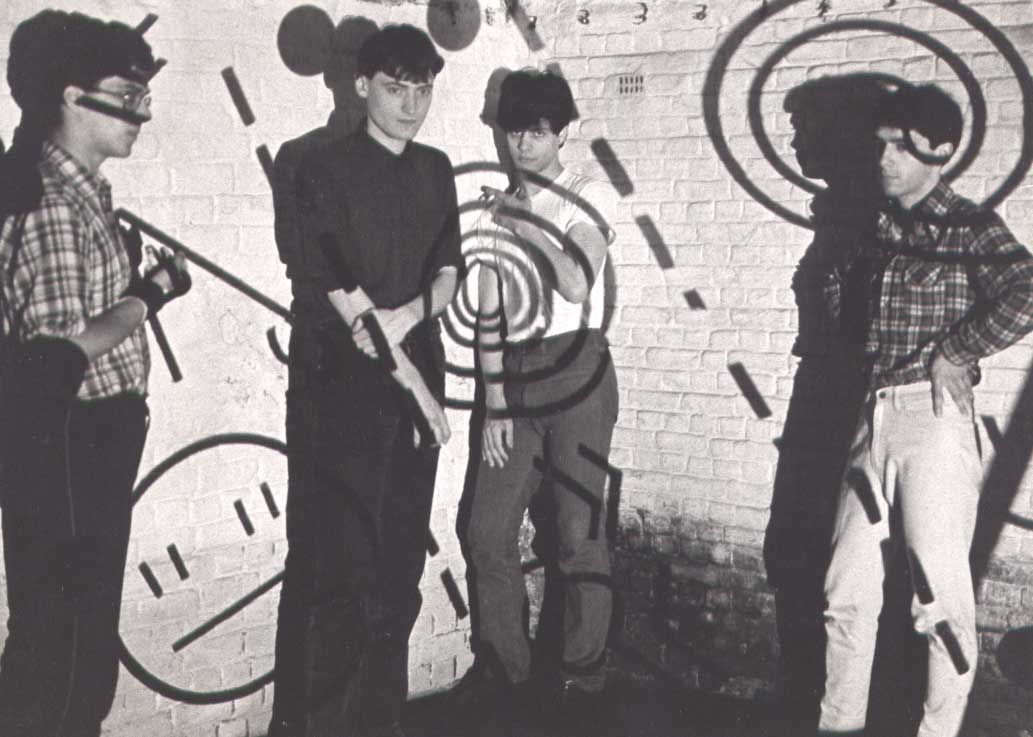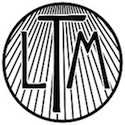Digital Dance \ Biography
By Drita Kotaji
Prior to forming Digital Dance in Brussels (Belgium) in the summer of 1978, Jerry WX (born Jean-Pierre Poirier in 1956) and Stephan Barbery (born Stéphane Maes in 1961) had been closely involved in the local punk scene.
Jerry WX played with Chainsaw (with Dan MacCroll, Bob Seytor and Micky Mike), the very first Brussels punk band in 1976, and a year later with X-Pulsion (with Peter Schlager and the Klang Brothers). Stephan Barbery played with Thrills (with Xavier S., Luc de Meersman and Alain Lefebvre) from 1977 to 1978. During this period X-Pulsion, Thrills and a third band called Streets (Bob Seytor, Phil Wauquaire, Jean-Michel Druart and Michel Zylbersztajn) played many gigs together, often swapping instruments and members.
Digital Dance took shape in July 1978, based around Jerry and Stephan, two complementary guitar players. The electronic/techno connotations of the name are slightly confusing, for DD might be better tagged as a post-punk-electro-funk-experimental group. The 'digital' element came from the French adjective relating to fingers (les doigts), the idea being to suggest the light taps produced when you rap your fingers. That said, both Jerry and Stephan were fans of Kraftwerk, Eno and new electronic music. As for the rest, both were also fond of dance and funk music, and Talking Heads.
At first the new duo were joined by a flexible pool of musicians, including Joel Van Audenhaege on vocals, M'Blahé or Michel Zylbersztajn on drums, Michel Duyck on bass, and Jean-Marc Lederman on bass keyboards. The first settled line-up came in October 1978, with Jerry (vocals, guitar, keyboards), Stephan (guitar), Jean-Marc (bass keyboards) and Michel Zylbersztajn (drums). They subsequently recorded a four track demo produced by sound engineer Marc François, (Hospital Dance, All Those Words, Cleaned Mind and I'm So Shy). François later produced the sole album by Josef K, with whom DD's atypically melodic brand of post-punk bears some comparison.
In July 1979 Disques Vogue released the first DD single, a 7" combining a cover of the Kraftwerk track Radio-activity with a Jerry WX original, Computer Rock. This period of intense activity also saw several notable live concerts, including the first opening of the celebrated Plan K venue on 18 May 1979, and support slots with Magazine and Siouxsie and the Banshees, all of which meant that the band were able to avoid gigging in small, traditional local venues too often.
In October 1979 bassist Phil Wauquaire also joined, allowing Jean-Marc to play additional keyboard lines and Jerry to concentrate on guitar and vocals. Digital Dance also recorded a second, self-produced 7" single, I Sleep on the Waves b/w Faulty, released on their own Digital label in January 1980. A second demo was also recorded. The single was picked up by John Peel in the UK, where it sold 200 copies through Rough Trade. DD also opened for Joy Division at their second Plan K show on 17 January 1980, and played a three night residency at the Gibus Club in Paris between 14-16 February 1980, billed as 'New Rock de Bruxelles'.
In March 1980 Jean-Marc and Phil both left, and soon afterwards joined Frank Tovey in Fad Gadget. Keyboards were not replaced, and new bassist Thierry Quotermans (aka TVIC, formerly with Isabelle and the Nic-Nacs) joined Jerry, Stephan and Michel in what proved the most stable and coherent version of Digital Dance. A third demo was recorded, again with Marc François, including songs such as Treatment, Human Zoo, No Reason, Sinking Tanker, Back From the Waves and Der Spiegelpaleis. The band subsequently released an eponymous C60 cassette, Digital Dance, including improvised and rehearsal recordings, which appeared early in 1981. As a result, Brussels indie label Sandwich Records invited the band to record, including Human Zoo on their compilation B9 released in May 1981. DD also contributed Cruelty to Walking After Midnight on the St Germain label.
However Digital Dance now entered a difficult period, with TVIC away on compulsory military service, during which the group's instruments were stolen, and further marred by the departure of Michel Zylbersztajn. This transitional period gave rise to Jung, a project from mid-1981 consisting of Jerry, Stephan, a rhythm box and a bassist named Gael. Jung recorded a three track single for Sandwich (SR17) combining The Real Thing with a version of Sinking Tanker and a cover of TV theme The Avengers, although financial problems at Sandwich meant that the record was not released.
In March 1981 Digital Dance recorded a third single, coupling Treatment with the lengthy Bad Meeting, again self-produced. By now TVIC had returned, and Alain Lefebvre joined on drums to complete the final line-up. Treatment was released on Dirty Dance Records, a label run by Micky Mike. During this period Digital Dance practiced every day, developing an improvisational ability, and making use of this skill during live shows. Some recordings remain, represented on this CD by The Night Suite and Common Denominator, recorded live on 3 December 1981 in Nancy (France), their penultimate gig.
A fourth DD single was also recorded Three Meanings b/w Cruelty for Sandwich (SR19), and sleeves printed. However the label ceased trading, and so like Jung the record remained unreleased.
As well as the collapse of Sandwich, during 1982 momentum was also dissipated by various parallel projects. Stephan and Alain joined the second version of Marine. Jerry worked on solo projects with machines and produced several cassettes, toured with Etat Brut and a;Grumh, then formed The Revenge. TVIC played with Three Hands, also joined Stephan for the Instead Of project, producing two cassettes. Stephan also ran his own cassette label, Camera Obscura, and became increasingly involved in the Belgian art scene as a mail art artist, painter, producer of 'graphzines', and graphic designer for the PIAS label.
Although Digital Dance played their last live show in Ottignies (Belgium) in mid-December 1981, there was no definite end to the band. Jerry and Stephan did not play together between 1982 and 1998, but the pair subsequently collaborated within the Ink project. Sadly, Jerry died in 2000. TVIC spent a long time in Africa, and is now retired. Today Stephan is one half of the duo Ink, along with Drita Kotaji (formerly with Berntholer). Stephan also continues his career as a graphic artist under the name LVP (La Vermine Persistante), and is involved in the unregardmoderne.com project with Loulou Picasso (formerly of Bazooka, the Parisian graphic art punk scene of the late 1970s).
Despite their difficult reputation and lack of commercial success, Digital Dance built up a cult following and were applauded by several leading Belgian rock music journalists (eg Bert Bertrand, Gilles Verlant, Nadine Milo), were ably supported by manager Nadine Bal, and in the studio by Marc François. Other musicians occasionally played with DD: Crackerjack, Bob Seytor, Michel Duyck, Marc Jonckers, members of Isolation Ward, and others. The various members subsequently played in groups as diverse as Fad Gadget, Marine, The Revenge, Kid Montana, Noh Mask, The Names, Snowy Red, The Weathermen and Ink.
Last, but not least, the punk years in Brussels generated many fanzines. Jerry ran Design, and Stephan Bobel Simplex. Digital Dance also published the Digital Magazine, at first initiated by Philippe Van Crombrugge (aka Crom), founder of the first Brussels punk fanzine Zip Vynils. The Digital Dance 'corporate image' was also devised by Stephan and Crom, taking in the production of various stickers, badges, packs of matches, flyers, brochures and posters. Stephan took charge of the layout and design of DD single sleeves, as well as stage design for live shows. Other artists collaborated on posters (Jean-François Octave, Dominique Maes), while the four-fingered hand that appears on the sleeve of I Sleep on the Waves was drawn by Patrice Verhofstadt.
Drita Kotaji
September 2007



![TREATMENT [LTMCD 2498]](../images/ltmcd2498.jpg)
![VARIOUS B9 [LTMCD 2486]](../images/ltmcd2486.jpg)